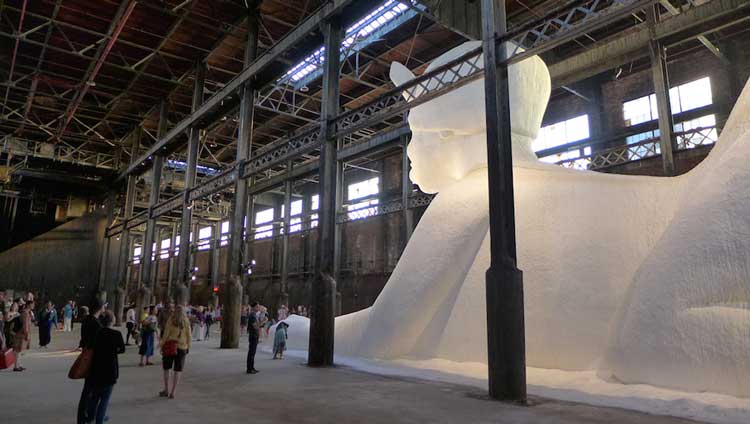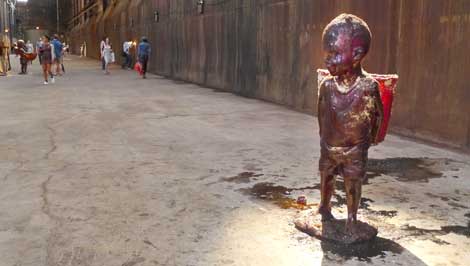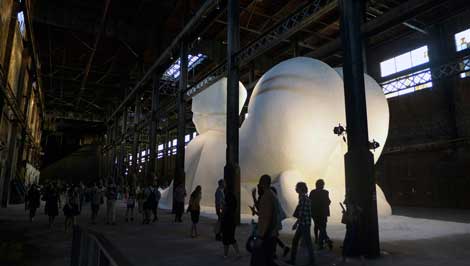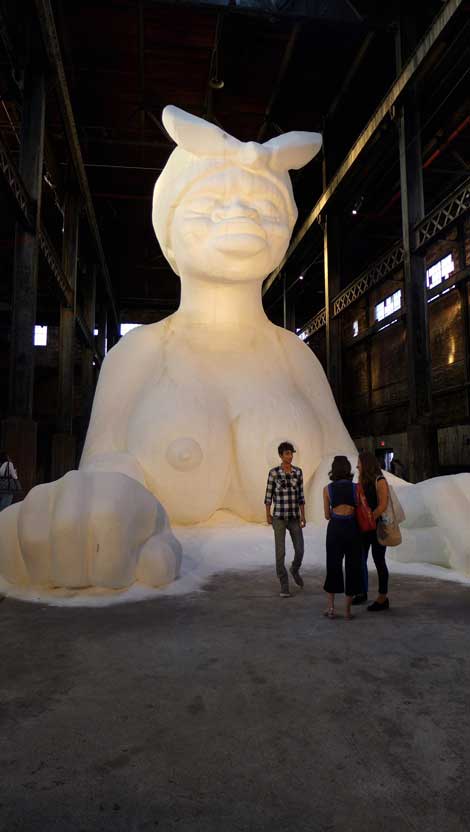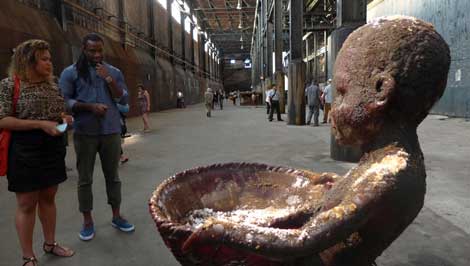Pierced by the oblique rays of a setting sun pouring in from the yellowing skylights, the bowels of the abandoned Domino’s sugar refinery in Brooklyn appear like the nave of a rusted cathedral. For two months this spring that majestic industrial ruin was the setting for Kara Walker’s impressively site-specific installation, ironically titled “A Subtlety” a meditation on desire, exploitation, denial and the bittersweet legacy of sugar organized by New York-based Creative Time art collective in advance of the factory’s partial demolition and conversion to residential river-view lofts.
The riverfront Domino Refinery in Williamsburg was built in 1856 when it was the largest sugar refining plant in the world. The factory remained operational until 2004 when the last 225 workers were laid off and the plant shuttered. In the intervening 148 years the refinery had produced untold tons of lily-white granulated sugar, at one point supplying up to half of the total consumed in the United States. Today it stands as a hulking brick monument to the industrial age and to New York’s manufacturing heritage, which is an ever fainter memory in today’s gentrified city.
It was in other words the perfect space for Walker to build her giant sugar Sphinx which stood in the cavernous space like a ghost of our collective past, emerging from the shadows after your eyes got used to the yawning gloom. Lying at one end of the empty factory floor the imposing sculpture made of sugar represented a giant negress prone in the enigmatic pose of the mythical ancient Egyptian beast. Powerful and voluptuous in her primordial curves, the figure was part Venus of Willendorf and part Mammy, an Aunt Jemima, with her kerchief tied around the head, evoking all the saccharine condescension that entails – especially on a factory floor still reeking with the scent of burnt molasses.
Subverting stereotype is of course familiar terrain for Walker, one she has repeatedly investigated, juxtaposing a childlike medium like paper cutouts for instance, with the jarringly brutal subject matter of the antebellum South stripped of its romanticized veneer. The location of “A Subtlety” was therefore ideally suited for her to excavate traces of an erased past but also to probe a present which is too conveniently removed. In the plant, around the sphinx, small figures were placed; diminutive brown babies, translucent and oozing sticky syrup, as if made of actual molasses. These cupid-like children held what appeared to be bunches of bananas or other fruit husks and large baskets ready to receive the fruits of some deceptively idyllic harvest. Like tiny workers angelically resigned to their labors they also had a more sinister, almost grisly dimension, appearing as if burned, like little ghosts of forgotten lynchings. Dark and sticky, these “tar babies” appeared to bear witness to centuries of silenced plantation abuse.
From colonial and slave economies to modern-day nutritional malpractice, sugar is of course freighted with heavy baggage, fraught with the racism and exploitation that goes back to the days of European and British sugar monopolies. An apt if fictionalized history of that heritage was given by director Gillo Pontecorvo in Burn, his 1969 follow-up to The Battle of Algiers, featuring Marlon Brando as the ruthless agent of English sugar brokers wreaking havoc a Caribbean island. More to the point conditions on modern-day plantations in places like Haiti and Santo Domingo have not improved that much from the indentured servitude upon which fabulous fortunes were built a century prior. The U.S. Dept. of Labor’s “List of Goods Produced by Child or Forced Labor” report lists sugarcane from the Dominican Republic as being produced with the help of child and forced labor. “A Subtlety” addressed that historical subtext as well as the willful ignorance of the blood sweat and tears behind our sweet tooth and the commodity which most epitomizes the blithe indulgence of Western gluttony.
Ten years ago Domino, a subsidiary of American Sugar Refining, finally closed the Williamsburg plant but it still maintains large refineries elsewhere, a dozen or so around the world (in Mexico, for example, and in Belize plus several in the U.S. and Canada). ASR is one of the biggest players in the sugar game and a subsidiary of the Fanjul sugar empire run by a family of Cuban expatriates who from their Florida base produce several national brands, including, Domino, Jack Frost and C&H Sugar, one of a handful of conglomerates that today control a billion dollar global business. They may not have the absolute ruthless control of their 19th century precursors but Big Sugar is still a mighty powerful concern commanding armies of lobbyists to secure vast government subsidies.
With her furrowed brow and stern gaze pointed straight into the middle distance, Walker’s sphinx seemed to have all that on her mind—and more. One of her hands, was clutched in the sign of the fig, the gesture with thumb thrust between middle and index fingers which represents female genitalia and can be alternately insulting or propitiatory of fertility—a concept certainly evoked by the figure’s colossal buttocks and exposed sex. The subtext of sexual politics intertwined with economic exploitation on cane plantations (or pretty much any plantation) were as integral a part of the piece as the inconvenient truths of the multimillion dollar industry that supplies the river of sweet indulgence flowing to western sugar-addicted palates.
The Great Sphinx of Williamsburg was also relevant in another exquisitely site-specific way. In its Brooklyn location it addressed the forces that eviscerate cities and towns, bulldozing buildings and erasing urban memories in the rubble. Of all neighborhoods in the country none is, of course, as emblematic of turbo-gentrification as is Brooklyn and especially Williamsburg. The speed and force with which it has transformed from an Italian, Puerto Rican and Hasidic neighborhood into a Millennial hipsterscape has notoriously made it a case study for contemporary urban transformation. The Domino plant is squarely in the crosshairs of that transformation as it is slated for “redevelopment” in the form of a 3.3 million square-foot, $2 billion mixed use megaproject that will include a 35-story, 369-foot tower with 658 residential units, which will essentially graft a string of Shanghai-style glass high rises on the old riverfront, virtually cutting off the neighborhood from the water.
Considering that, as cupcakeries and pet spas push into Bushwick, Red Hook and Bedford Stuyvesant, gentrification’s present frontier is black Brooklyn, it was hard not to see the Sphinx and its phantom-children as soon-to-be ghosts of a doomed African American cultural identity—“museum negroes” if you will, of near future memory. And what should a monument do if not stoke and confront us with our memories?
Photos by Luca Celada

